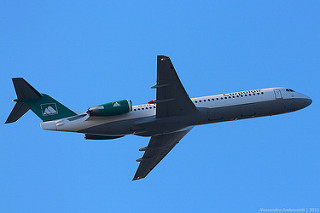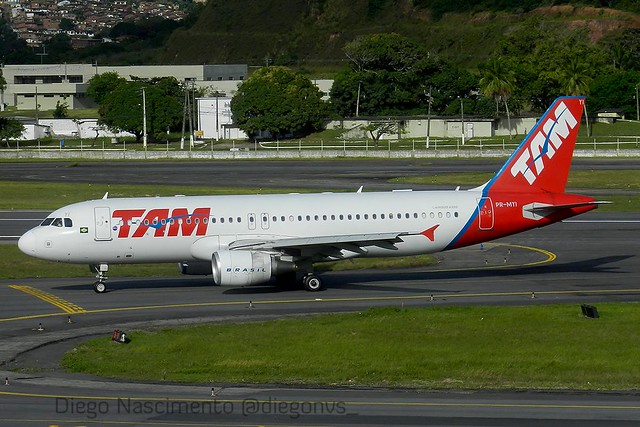Carpatair SB20 at Craiova on Feb 13th 2012, runway excursion during takeoff
Last Update: December 21, 2020 / 22:51:37 GMT/Zulu time
Incident Facts
Date of incident
Feb 13, 2012
Classification
Accident
Cause
Runway excursion
Airline
Carpatair
Flight number
V3-2385
Departure
Craiova, Romania
Destination
Timisoara, Romania
Aircraft Registration
YR-SBK
Aircraft Type
SAAB 2000
ICAO Type Designator
SB20
Airport
Craiova Airport, Craiova
Airport ICAO Code
LRCV
The airport reported the aircraft was taking off in low visibility when the aircraft went off the runway about half way down the 2500 meter long runway. Two passengers were taken to hospital, the aircraft received damage to gear and both propellers. Snow removal had been underway throughout the day.
The airline reported the aircraft veered off the runway after the right hand main gear went through a snow bank on the runway, none of the occupants received any injuries. The damage to the aircraft is being assessed.
Some time in the past Romania's CIAS released their final report concluding the probable causes of the accident were:
Human error generated by following facts:
- The take-off conditions exceeded the training level of the crew.
- The changing of the take-off procedure, without previous training.
Favorable cause:
- inappropriate runway snow removal.
The CIAS summarized the sequence of events:
The aircraft was parked at Craiova Airport. The aircraft was prepared for the flight and, after the passengers boarding, it rolled on the taxiway B and, then, on the runway in order to align and to take off from the runway 09. The taking-off conditions were with low to medium snow, the taking-off surface being covered with a layer of dry snow. After the successive snow runway removal actions, in the lateral areas of the declared runway, including the line of the bright light marking lamps, there were snow accumulations of about 1 m.
The aircraft was aligned on the runway in order to takeoff and, after getting the approval, it began the roll in order to takeoff. During the roll the aircraft deviated laterally to the right side, it hit the snow bank with the right engine propeller, formed after removing the snow from the runway, and it went out in the runway strip almost 20m.
After the aircraft stopped, the crew proceeded to the emergency evacuation of persons on board, according to the specific procedures. The captain (43, ATPL, 6,623 hours total) informed TWR and requested emergency assistance.
The persons on board left the aircraft through the emergency exists.
The aircraft sustained substantial damage, all propeller blades on both propeller had separated, there was damage to the nose section and forward section of the fuselage amongst other damage to wing roots, gear bays and doors etc. The aircraft manufacturer stated the damage was repairable.
The CIAS analysed:
According to the information submitted to the crew, the weather conditions and the runway state were within the minimum standards set by the company for operating the aircraft type SAAB 2000.
Based on the analyzed information it wasn’t identified any aircraft failure that might have led to the occurrence of this incident.
After the repeated snow removal from the runway, in order to maintain its state of operability, there resulted snow accumulations, which have been compacted.
As a result of the deviation from the runway axis, to the right, during take-off, the engine no.2 (R/H) propeller blades touched the accumulated and compacted snow, were broken, losing the trust on engine no. 2 which generated a sudden turning to the right, the aircraft continuing to move almost perpendicular to the runway axis. Successively, the aircraft came into contact with the snow accumulation, with the right main landing gear leg, with the nose landing gear leg, then with the engine no. 1 (L/H) propeller blades, causing their rupture, ending with the left main landing gear leg. The asymmetry of the traction generated by successive blades ruptures of the two propellers could not be countered by the crew in due time. The aircraft stopped at almost 30 m laterally right side on the runway strip.
Taking into consideration the indications from Chap. 7 of the ICAO Doc 9137, Part II, the snow from the runway was not removed appropriately, the lighting lamps being covered with snow, and the snow removal was not homogenous all over the runway surface. Furthermore there were no positions markers of the runway side lamps required by Romanian civil aeronautical regulation RACR-AD-PETA, section 5.5.4.11 - 5.5.4.3 and ICAO Doc 9137 Part II.
The lack of markers, in front of runway side lamps, determined that the lateral delimitation of the runway through snow removal not to be rectilinear and parallel to the runway axis. The aircraft crew, who was not seeing the runway axle markings (covered by a thin snow layer), assumed, wrongly, that the snow accumulations (banks) represent two lines parallel with the runway axis.
The captain changed the takeoff procedure in the moment when the aircraft was aligned for take-off, trying to adapt it to the existing conditions. The captain actually established new tasks for the copilot (29, CPL, 700 hours total), an operating mode that both were not familiar with. The flight recorders data show the existence, during the take-off process, of a short interval when both pilots read, simultaneously, the board indicators, successively announcing the reaching of the V1 speed.
It is considered that none of the pilots could any longer maintain the take-off direction in relation to the chosen reference, in the given conditions (the time for adapting the sight, from inside the cabin to outside being longer than the one the crew had available at the moment). The take-off heading was kept until the proximity of V1, when the direction was lost, probably lacking reference points. The deviation to the right was accentuated by entering a runway section covered with 5-7 cm thick compacted snow, generating a differential braking on the landing gear wheels. This determined the impact with the snow banks, initially with the right propeller blades and left engine and the aircraft’ exit from the runway.
The people onboard, the passengers and the crew members, left the aircraft according to the applicable emergency procedure for this aircraft type, jumping into the snow. The height, from which they jumped into the snow, leaving the aircraft, was 50 – 70 cm, depending on the emergency exit they used.
Relevant NOTAM:
A0331/12 - RWY 09/27 CLOSED. 13 FEB 10:24 2012 UNTIL 13 FEB 17:30 2012. CREATED: 13 FEB 10:24 2012
Metars:
LRCV 131030Z 11004KT 1500 -SN BR SCT004 BKN006 OVC016 M06/M07 Q1015
LRCV 131000Z 10006KT 0600 SN FZFG BKN003 OVC005 M06/M08 Q1015 09492093
LRCV 130930Z 09006KT 0400 SN FZFG BKN002 OVC004 M07/M08 Q1016 09492093
LRCV 130900Z 08004KT 0500 SN FZFG SCT002 BKN004 OVC006 M06/M07 Q1016 09492093
LRCV 130830Z 06008KT 0500 SN FZFG BKN002 OVC004 M07/M08 Q1016 09492093
LRCV 130800Z 00000KT 0500 SN FZFG SCT002 OVC006 M06/M07 Q1017 09492093
LRCV 130730Z 15004KT 120V180 0500 SN FZFG BKN002 OVC004 M07/M07 Q1017 09492093
LRCV 130700Z 10006KT 0700 SN FZFG BKN002 OVC004 M07/M08 Q1017 09492093
Incident Facts
Date of incident
Feb 13, 2012
Classification
Accident
Cause
Runway excursion
Airline
Carpatair
Flight number
V3-2385
Departure
Craiova, Romania
Destination
Timisoara, Romania
Aircraft Registration
YR-SBK
Aircraft Type
SAAB 2000
ICAO Type Designator
SB20
Airport
Craiova Airport, Craiova
Airport ICAO Code
LRCV
This article is published under license from Avherald.com. © of text by Avherald.com.
Article source
You can read 2 more free articles without a subscription.
Subscribe now and continue reading without any limits!
Read unlimited articles and receive our daily update briefing. Gain better insights into what is happening in commercial aviation safety.
Send tip
Support AeroInside by sending a small tip amount.
Related articles
Carpat A319 at Frankfurt on Jul 3rd 2023, aligned with taxiway during swingover
A CarpatAir Airbus A319-100 on behalf of Baltic Air, registration YR-ABA performing flight BT-243 from Riga (Latvia) to Frankfurt/Main (Germany), was…
Carpatair F100 enroute on Jun 6th 2019, smoke in cabin
A CarpatAir Fokker 100, registration YR-FKA performing flight V3-2930 from Luxembourg (Luxembourg) to Vilnius (Lithuania) carrying the national…
Carpatair F100 at Amsterdam on Aug 27th 2018, navigation computer failure
A Carpatair Fokker 100 on behalf of KLM, registration YR-FZA performing flight KL-1779 from Amsterdam (Netherlands) to Hamburg (Germany), was…
Carpatair F100 at Gallivare on Apr 6th 2016, overran runway on landing
A Carpatair Fokker 100 on behalf of Nextjet, registration YR-FZA performing flight 2N-4856 from Arvidsjaur to Gallivare (Sweden) with 50 passengers…
Carpatair AT72 at Rome on Feb 2nd 2013, runway excursion on landing, main and nose gear collapsed
Italy's ANSV released their final report in Italian concluding the probable cause of the accident was:Human Factors.In particular the accident was…
Newest articles
Dana MD82 at Lagos on Apr 23rd 2024, runway excursion
A Dana Air McDonnell Douglas MD-82, registration 5N-BKI performing flight 9J-352 from Abuja to Lagos (Nigeria) with 83 passengers and 6 crew, landed…
LATAM Brasil A320 at Brasilia on May 13th 2024, engine shut down in flight
A LATAM Brasil Airbus A320-200, registration PR-MYI performing flight LA-3008 from Sao Paulo Congonhas,SP to Brasilia,DF (Brazil) with 106 people on…
Subscribe today
Are you researching aviation incidents? Get access to AeroInside Insights, unlimited read access and receive the daily newsletter.
Pick your plan and subscribePartner

A new way to document and demonstrate airworthiness compliance and aircraft value. Find out more.

ELITE Simulation Solutions is a leading global provider of Flight Simulation Training Devices, IFR training software as well as flight controls and related services. Find out more.

Your regulation partner, specialists in aviation safety and compliance; providing training, auditing, and consultancy services. Find out more.
AeroInside Blog
Popular aircraft
Airbus A320Boeing 737-800
Boeing 737-800 MAX
Popular airlines
American AirlinesUnited
Delta
Air Canada
Lufthansa
British Airways




